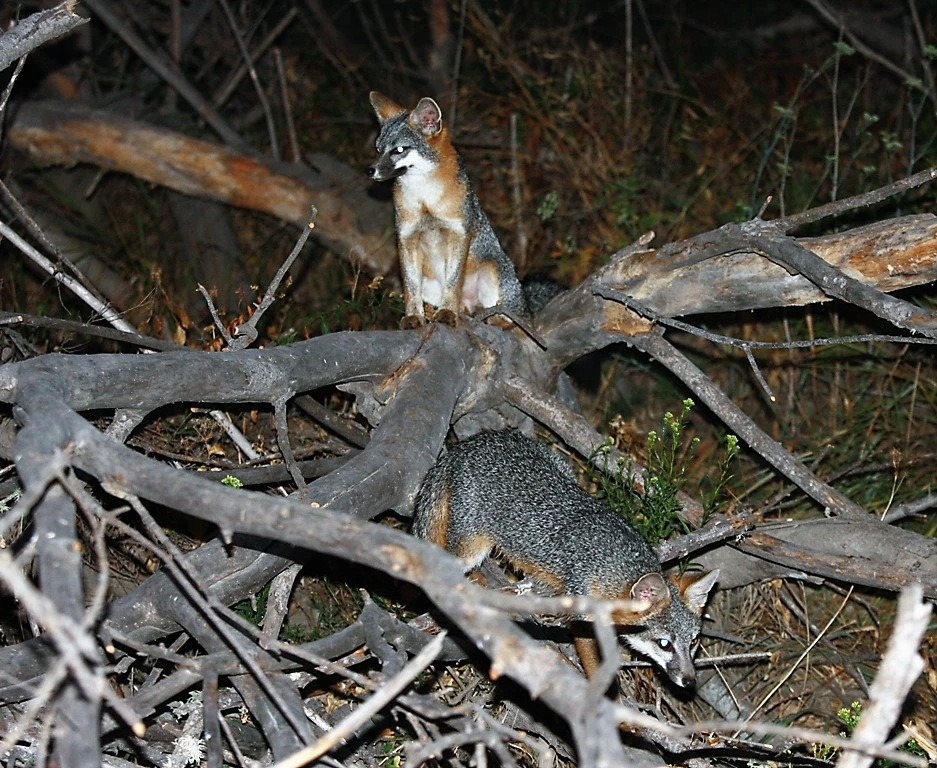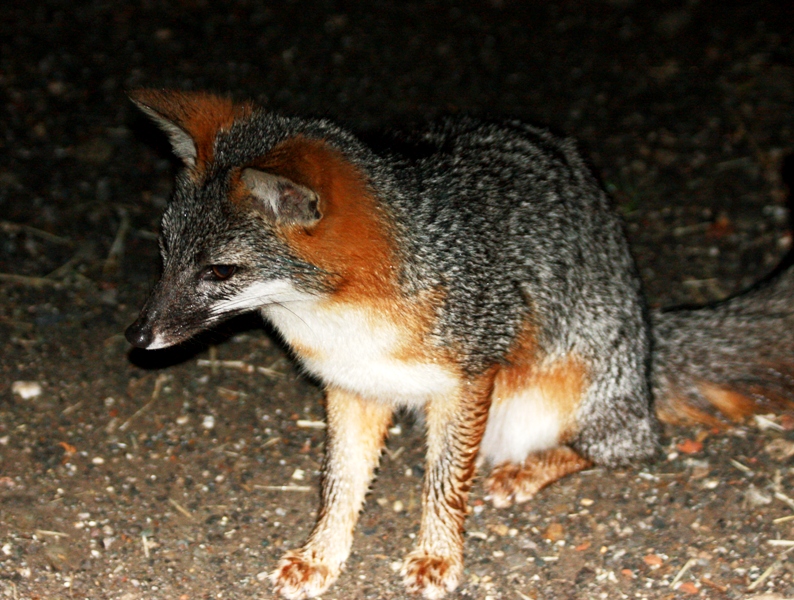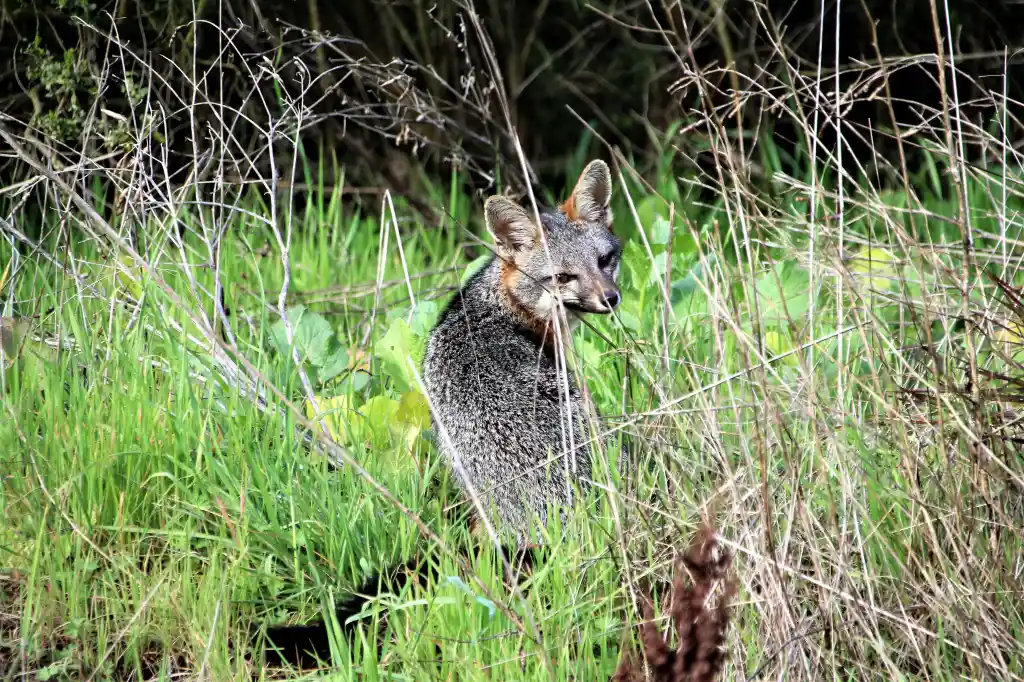Gray Foxes at Night
by William C. Leikam
President, CEO & Co-founder, Urban Wildlife Research Project
From even those early days of watching the behavior of the gray fox both live and on the trail cameras, it became apparent that what was common knowledge, about these nocturnal gray foxes was that they spent their active hours hunting and foraging for food to fill a hungry stomach. Is that true? Is that all they do for from eight to twelve hours most every night when they are out and away from their den? The peer reviewed literature reports that approximately 78% of their hunting is done at night. Of that 22% remaining, some of that hunting time takes place after sunrise and before sunset so that leaves a lot of time to get food.
My observations, once again live and on trail cameras, show that gray foxes do not spend all of their night hours hunting. They do a wide variety of things in the night. When a pair of gray foxes has a litter of pups, those pups soon reach a point early in their lives where a parent will take them out on training missions. Starting sometime within the first 6 – 8 weeks of their lives the pups are taught how to climb. Climbing is not innate.

In 2014 Mama Bold and her mate Gray gave birth to five healthy pups. About six weeks after being born, Papa Gray led his pups to the big blue gum eucalyptus tree to show them how to climb. Three of his five pups wrestled with or chased each other. Without a second thought, Gray climbed to about eight feet off the ground. One of the pups watched. Gray came back down, jumping the last couple of feet to the ground. Two of the pups ran to the tree, reached as high as they could, kicked their hind legs up beneath them and at the same moment reached higher. One of the pups had some difficulty with that synchronized push-grasp-pull and fell. That did not deter him. He turned back to the tree and went again and this time he didn’t fall but then again, he didn’t get very high. The other pup carefully climbed to about four feet, then turned and came back down to the ground just as gray had done. By this time, the rest of the litter climbed to one extent or another and to varying heights and with varying levels of confidence. From what I saw, they needed a few more tries before they get the trick down and to where it becomes second nature for them. Tree climbing is a survival tool.
On other occasions, at night the foxes may nap off and on for upward of 20 minutes, but more usually for about 10 minutes. Frequently, when Laimos and mate Big Eyes are out travelling the night together, they not only hunt together but they play. Laimos will see Big Eyes coming. He gets down tight to the ground, not taking his eye off of her. Suddenly, he springs to life and in a couple of the video clips they rear up on their hind legs and give each other a hug. Then it’s down to the ground and they chase each other. At times they even play what looks to me like tag; one chases the other, catches up, and then the one being chased turns and chases the other. They also encounter and have to deal with other critters of the night like the coyotes that prey on them, raccoons, opossums and skunks. How much of their night is taken up by such activities, I’m not sure, but I do know that their night is not a fever pitched hunt to fill one’s stomach and assuage hunger.

Gray Foxes General Health
For the past week or so, the female Big Eyes has been limping a little and biting at her right front paw. It looks as if she has something lodged in her paw-pad. If so, it will fester, break and heal.
From my initial observations, Canine Distemper is present most likely in both gray foxes. It may be that the head shaking that I noted a couple of months ago is related to distemper although in the literature there is no mention of such.
Total Numbers of Gray Foxes in the Palo Alto Baylands Nature Preserve
As of November 2020, we have two adult gray foxes living in the Palo Alto Baylands Nature Preserve.
Section II
Update for the Urban Wildlife Research Project
The collaring project needs $35,000 and here’s the reason why you should consider a donation to UWRPPlease consider a donation be it $1 or $5,000 dollars so that we can begin the collaring project dedicated to making the baylands along the San Francisco Bay a healthy place for wildlife to live.
Check out our Facebook page.
You can donate through PayPal or Give Direct, our preferred method for giving. On our website (Urban Wildlife Research Project), check out the short video and go to the donate button on the left of the page. Your donation is tax deductible.
Check out Bill’s interview of July 2, 2020 on Facebook Live https://www.facebook.com/beprovided/live
Bill will be doing an online show with the renowned artist John Muir Laws in December. Date has not been set but it will air from noon until 1:00 or 1:30 PM.
You can access Bill’s PowerPoint presentation Corridors & Connections: Sustaining the Health of All Wildlife presented during the October 24th P-22 Urban Wildlife Festival here: https://www.youtube.com/watch?v=Dh4MQL1D1Cc
To find out more about us, search Urban Wildlife Research Project, UWRP, gray foxes, wildlife connection, linkages, corridors and several documentaries and clips on YouTube
If you haven’t had a chance to read some of the articles that have been written about our study of gray fox behavior and our corridor work, click on these links as they will take you to the source: Bill Leikam – The Fox Guy, and Greg Kerekes & URWP
Section III
Gray Fox, Baylands Goals
Within the permit that allows the Urban Wildlife Research Project to conduct its study of the behavior of the gray fox at the Palo Alto Baylands Nature Preserve, the objectives covered area:
- Monitoring of urban gray fox Denning sites in Palo Alto Baylands.
This is being accomplished during the period when the gray foxes use a den site. It is one of the prime locations for gathering most of the behavioral data of the litter and for adults alike.
- Assessment of status and population trends of Baylands urban gray foxes
Since January 2019 a pair of resident gray foxes have claimed territory at the Palo Alto Baylands Nature Preserve.
- Identification of habitat features that promote the presence of urban gray foxes
After considering this and talking with people who know how to restore habitats, we need to assess what kinds of plants, including the Alkaline Salt Bush, would grow best along the edge of the saltwater channel and alongside the marsh. We need to grow a permanent habitat that contains the corridors and plant it as soon as possible. We’ll keep an eye on this as this is a critical link between the southern region of the Baylands and the northern region.
- Assessment of reproductive success and identification of factors that promote successful reproduction
Open up the pinch-point along Matadero Creek by developing thickets that link one area to another, instead of the present “islands”.
- Identification and assessment of possible dispersal travel routes.
Presently there can only be guesses as to dispersal travel routes. We intend to make this important question much more concrete when we attain our collaring/take/capture permit from the Department of Fish & Wildlife.




